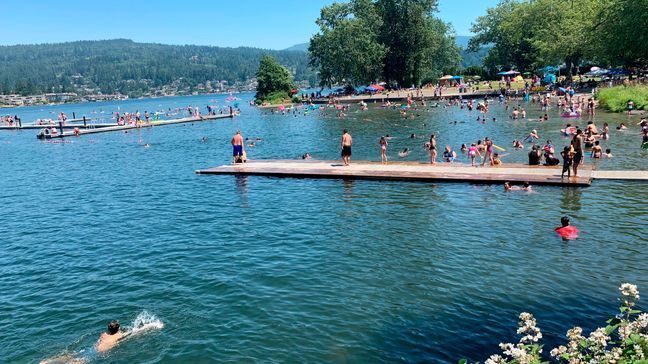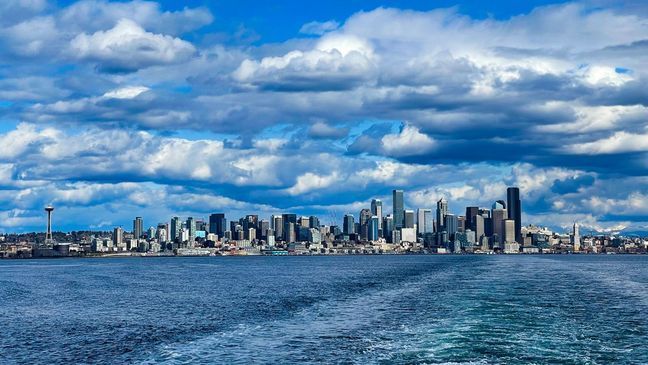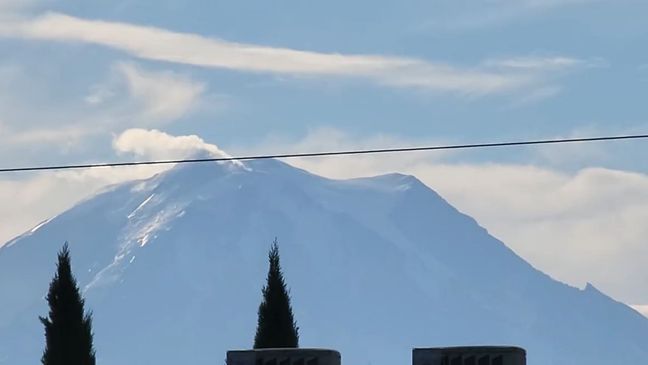Dry summer, smoky fall and an icy winter: A look at 2022's weather events
WASHINGTON — Western Washington weather never ceases to amaze! Our autumns are typically fast, and our springs slow to show. The year 2022 was no different. A late spring turned into a never-ending summer, autumn came and went within a blink of an eye, and winter kicked off cold and snowy.
Here are some of the top weather moments of 2022:
Impactful flooding rings in 2022
This year's weather saga starts back in late December 2021, when the Sea-Tac Airport recorded five consecutive days of measurable snow to end the year. This stretch of snow was followed by the fifth wettest first week of January on record.
Flooding and avalanches ensued as a result of widespread mild rain, closing major thoroughfares and cutting Seattle off from Portland and Spokane Friday, Jan. 7. In addition, coastal flooding caused damage in North Sound from the infamous King Tide. What a way to start the year!
Volcanic eruption impacts weather in Puget Sound
On Jan. 15, 2022, a volcanic eruption halfway across the world triggered Tsunami Advisories along the West Coast of the U.S. and impacted the weather in Puget Sound. An eruption on Hunga Tonga–Hunga Haapai, a submarine volcano in the Tongan archipelago in the southern Pacific Ocean, sent pressure shockwaves around the globe, temporarily clearing fog at the Sea-Tac Airport.
Check out the video of the clearing below from one of KOMO News' tower cameras:
Imagery from the Himawari-8 from NOAA/CIRA. Check out the video below created by Dakota Smith (@weatherdak).
June brides beware
Flash forward to June 9, when every weather reporting station across western Washington set a daily rainfall record. Seattle saw its 6th wettest June day ever, with 1.10 inches in the rain gauge. Flooding ensued along the Skagit River. The spring season was on pause.
Driest summer ever
If spring started late, then summer lasted long. Summer of 2022 was the driest ever in Seattle.
From June 21 to Sept. 22, only 0.50” of rain fell in Seattle. Summer was also warm, with a record-setting 13 days at or above 90 for the year. Out of those 13 days, a record-setting 6 consecutive days at or above 90 degrees occurred in late July.
Saturday, Sept. 10, Seattle hit 92, marking the last 90-degree day of the year. Typically, Seattle averages three days at or above 90 degrees for any given year.
Bolt Creek fire
The late, long summer gave way to late-season wildfire smoke. During the weekend of September 9-11, wildfire smoke brought unhealthy air to western Washington. The Bolt Creek Fire forced evacuations in Index and Highway 2 to close.
Ash fall was reported as far west as Edmonds.
Mt. Rainier's questionable cloud
A questionable-looking cloud on Mt. Rainier Sept. 2 caused quite the stir on social media. People thought the mountain might be venting due to a possible eruption, but it was not.
Check out the explanation of what happened below from KOMO News Meteorologist Kristin Clark:
Oddly warm, dry October
October 2022 was oddly warm and rain-free. Seattle reached 88 degrees on Sunday Oct. 16, the latest 80-degree day ever observed for Seattle and Olympia. This was also the second hottest October day in 130 years of records. The hottest October day ever was 89 degrees on Oct. 1, 1987.
Extended wildfire season into fall
We've come to expect wildfire smoke every August and September during our seasonal dry spell of weather. But for the smoky haze to linger into October was unusual.
Typically, the wildfire season-ending rain arrives by this time of year. But after experiencing the driest summer on record, followed by some of the warmest conditions ever in October, fires were still smoldering, and the smoke lingered. On Oct. 20, Seattle had the worst air quality of all the major cities worldwide.
Flash fall
The change in average temperature between October and November 2022 was the biggest one-month drop in Seattle history (57.6F to 41.9F).
But the Doppler went quiet midway through November. The Sea-Tac Airport tallied a record-long stretch of dry weather, with fourteen days straight of no measurable rain. Previous Seattle record for most consecutive dry days in November was 13 days from November 10-22, 2000.
Week of weather warn
The lowlands experienced a long-duration snow event from Nov. 29 through Dec. 4. For six days straight, Seattle recorded measurable snow each day, tying for the fifth longest streak of all time.
Several inches of a wet snow blanketed the lowlands with the weight of the moisture-laden snow resulting in extensive tree damage and power outages in North Sound. On Dec. 3, 2.6” of snow fell, which is more than what Seattle averages in all of December.
End of the year ice storm
The end of the year brought a series of challenging storms in terms of weather forecasting. Topping it off was a rare ice storm in Puget Sound.
It was the Friday before Christmas. What could go wrong? Just the worst ice storm Puget Sound has seen since 2012. Other major storms across the country wreaked havoc on holiday travel, from a deadly blizzard in Buffalo, NY to extreme cold across much of the nation in the days leading up to Christmas.
Stay connected with KOMO News on Facebook, Instagram, Twitter, and TikTok. Download the KOMO News app here for the latest news, traffic, and weather.



